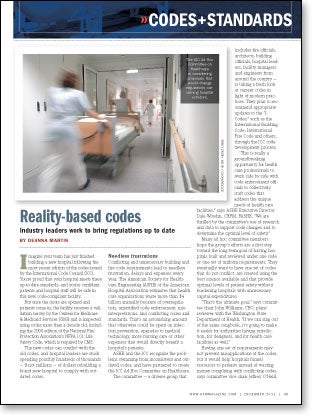Reality-based codes

Imagine your team has just finished building a new hospital following the most recent edition of the codes issued by the International Code Council (ICC). You're proud that your hospital meets these up-to-date standards, and you're confident patients and hospital staff will be safe in this new, code-compliant facility.
But once the doors are opened and patients come in, the facility receives a validation survey by the Centers for Medicare & Medicaid Services (CMS) and is inspected using codes more than a decade old, including the 2000 edition of the National Fire Protection Association's NFPA 101: Life Safety Code, which is required by CMS.
The new codes can conflict with the old codes, and hospital leaders are stuck spending possibly hundreds of thousands — if not millions — of dollars rebuilding a brand new hospital to comply with outdated codes.
Needless frustrations
Conflicting and unnecessary building and fire code requirements lead to needless frustration, delays and expenses every year. The American Society for Healthcare Engineering (ASHE) of the American Hospital Association estimates that health care organizations waste more than $4 billion annually because of overregulation, unjustified code enforcement, misinterpretations, and conflicting codes and standards. That's an astonishing amount that otherwise could be spent on infection prevention, upgrades to medical technology, more nursing care or other expenses that would directly benefit a hospital's patients.
ASHE and the ICC recognize the problems stemming from inconsistent and outdated codes, and have partnered to create the ICC Ad Hoc Committee on Healthcare.
The committee — a diverse group that includes fire officials, architects, building officials, hospital leaders, facility managers and engineers from around the country — is taking a fresh look at current codes in light of modern practices. They plan to recommend appropriate updates to the "I-Codes," such as the International Building Code, International Fire Code and others, through the ICC code development process.
"This is really a groundbreaking opportunity for health care professionals to work side by side with code enforcement officials to collectively craft codes that address the unique needs of health care facilities," says ASHE Executive Director Dale Woodin, CHFM, FASHE. "We are thrilled by the committee's use of research and data to support code changes and to determine the optimal level of safety."
Many ad hoc committee members hope the group's efforts are a first step toward the long-term goal of having hospitals built and reviewed under one code or one set of uniform requirements. They eventually want to have one set of codes that do not conflict, are created using the best science available and that provide optimal levels of patient safety without burdening hospitals with unnecessary capital expenditures.
"That's the ultimate goal," says committee chair John Williams, CBO, plans reviewer with the Washington State Department of Health. "If we can sing out of the same songbook, it's going to make it easier for authorities having jurisdiction, for designers, and for health care facilities as well."
Having one set of requirements may not prevent misapplications of the codes, but it would help hospitals funnel resources to patients instead of wasting money complying with conflicting codes, says committee vice chair Jeffrey O'Neill, AIA, ACHA, senior project manager at the University of Pennsylvania Health System in Philadelphia.
"That's why this process is so exciting to all of us," O'Neill says. "We'll always have our state departments of health, our local fire groups and building plan review groups, but having them looking at the same book at least begins to have some consistency throughout what we're doing."
The committee is focused solely on examining the I-Codes and determining appropriate changes to submit. It is only dealing with changes affecting hospitals and ambulatory care facilities, not nursing homes and other residential facilities.
Years in the making
The committee's goal of providing high levels of safety without wasting resources requires a comprehensive examination of code concepts developed decades ago. In recent years, hospitals have had exemplary fire safety records largely due to the shift toward fully sprinklered buildings; improved construction practices; the reduction of flammable liquids; better electrical, medical gas and ventilation systems; more staff training; and the proliferation of nonsmoking policies.
While those changes drastically have improved hospital safety, other code requirements added over the years have done little to protect hospital patients, health care workers and first responders. And many involved with the code process fear that certain requirements are being written into codes simply to advance a product line and protect a company's bottom line without providing significant improvements to safety.
Jon Nisja, with the Fire Marshals Association of Minnesota, wrote in an editorial published in the spring 2011 edition of Fire Marshals Quarterly that code development is approaching a crossroads.
"Will it continue to be a tool to save lives, reduce fires, and minimize property damage or will it transition into a process that favors profits, turf, and market share over protecting society as a whole from the ravages of fire?" he wrote. "Will it continue to be a valuable resource for a community wishing to positively influence fire and life safety, or will it become a book of confusing and incongruent regulations that cost billions of dollars and provide minimal benefit?"
One example of a change being considered by the committee is a clarification of corridor width requirements in hospitals, an issue that has nagged facilities for years and is reported to be among the top causes for Joint Commission citations.
Currently, the I-Codes require hospital corridors to have 8 feet of clear and unobstructed width. But the day-to-day operations of a hospital require some wheeled equipment near patient rooms at certain times, including life-saving crash carts, isolation carts and patient lifts. While some code enforcement authorities allow wheeled equipment to be staged temporarily in 8-foot corridors, others interpret the I-Codes to require 8 feet of completely clear corridor space at all times.
The requirement for 8 feet of clear corridor space originally was put in place decades ago to ensure patients could be wheeled out of their rooms on beds during fire evacuations. But hospitals now use defend-in-place procedures and have quick-response automatic sprinkler systems that rapidly extinguish fires in the room of origin, eliminating the need for risky patient evacuations.
The committee wants to clarify the I-Codes to spell out exactly what types of wheeled equipment can be staged in corridors, as long as a space of 5 feet remains clear and the equipment can be moved in case of an emergency. The committee conducted research and found that patient beds still can be wheeled out of a room with 5 feet of clear space. By backing its proposal with research, the committee hopes to obtain a more consistent and realistic application of codes while keeping the means of egress usable for staff and others during a disaster.
Although the committee is suggesting changes only to the I-Codes, it also is reviewing the checklist for CMS surveyors, referred to as "K-Tags," to ensure that the issues CMS identifies as especially important are addressed in the I-Codes and supported by current data. The committee's proposals sometimes reference other consensus codes, including those published by the NFPA.
Building on science
"We're trying to reference the documents out there that were built on science and work away from those elements that had no science behind them when they were put in the code," says David Howard, director of facilities management for Penrose-St. Francis Health Services in Colorado. "We're not trying to slight safety or do anything but provide the ultimate level of safety, but from a cost standpoint that really does make sense."
In working to pull together proposals on appropriate code changes, the committee has sifted through research from the National Institute of Standards and Technology, NFPA and computer modeling being performed by fire protection engineers. Because the group contains professionals from different backgrounds, the committee and work group meetings have led to lengthy discussions about some issues. But bringing everyone together has led to a better understanding, says committee member Tim Peglow, P.E., associate vice president for patient care and prevention facilities at the University of Texas MD Anderson Cancer Center in Houston. "The best part of the process is the hospital people sitting next to the fire code people and helping to educate each other about the issues and challenges," he says.
Committee member and Virginia State Fire Marshal Ed Altizer, P.E., CBO, CFO, says he is glad to be part of the committee because he wants to help create the best possible codes to protect people from fire. "It's always good to get people together to talk about their problems and try to get the problems resolved," Altizer says.
Any differences of opinion that arise are helpful in the long run, says Williams, the committee chair. "We're going to get a better product by fleshing out those concerns and vetting proposals beforehand."
ASHE Advocacy Director Chad Beebe, AIA, SASHE, CHFM, CFPS, CBO, says it's critical for health care professionals and others who have a stake in hospital regulations to get involved with the ICC process. "This is a great chance for people to make their voices heard and have a real impact on codes," Beebe says. "We know all too well about the problems with conflicting codes, and now we have a chance to do something about it."
The committee will finish its work this month and submit proposals before an ICC deadline of January 3. ICC code development hearings, where these proposals will be voted on, are scheduled in Dallas from April 29 to May 6. The deadline for public comments on the changes approved in April is August 1, and a final action hearing is scheduled for October 24-28 in Portland, Ore.
Deanna Martin is senior communications specialist at the American Society for Healthcare Engineering. Her email is dmartin@aha.org.
| Sidebar - Key health care issues under consideration |
| Some of the key issues being considered by the International Code Council (ICC) Ad Hoc Committee on Healthcare include the following: » Corridor width Currently hospital corridors are required to have 8 feet of clear, unobstructed width, despite the operational need for certain wheeled equipment such as crash carts to be staged near patient rooms. The committee found that 5 feet of clear space is enough for safety purposes and is recommending that certain wheeled equipment be allowed in hallways as long as 5 feet of clear space remains and the equipment can be moved in an emergency. » Defend-in-place practices Hospitals long have used defend-in-place techniques during emergencies because sudden evacuations could harm patients, including those on life support, those who could be harmed by outdoor elements, and those who are at risk for wandering away from the facility. The "I-Codes" recognize that hospitals use defend-in-place strategies and include requirements for smoke compartments, areas of refuge and other features needed to execute defend-in-place techniques. However, the I-Codes do not include a definition of defend-in-place, so the committee supports adding a definition to the International Fire Code and the International Building Code to provide clarity for code officials. » Visual and audible fire alarms The committee wants to clarify that certain areas of hospitals, including operating rooms, should not be required to have loud fire alarms or strobe lights because the sudden blast of noise or a flash of light could interrupt delicate surgery or other patient care and cause patient harm. » Elevator lobbies The committee is considering a change that would no longer require enclosed elevator lobbies in hospitals that are protected by automatic sprinkler systems meeting certain requirements. Elevator lobbies serve no fire protection purpose for hospitals since they defend in place. This change would restore the code language that appeared in previous editions of the International Building Code, which did not require hospitals to provide elevator lobbies if the building had fire sprinklers. » Floor openings The National Fire Protection Association's NFPA 101: Life Safety Code has allowed the installation of stairs not used for exit access to connect two floors, such as in surgery rooms with observation areas above them. Such stairs also are useful when two departments with frequent contact, such as the emergency room and imaging spaces or admissions and medical records rooms, are located on separate floors. The committee is considering a proposal to the I-Codes that would clarify that these "convenience" stairs are permitted in hospitals. » Smoke control The committee is considering a proposal that would not require smoke dampers in hospitals where the HVAC system is fully ducted and the building has an automatic sprinkler system. » Ceilings and smoke partitions Current codes can be interpreted to require hospitals to extend smoke partition walls above the height of lay-in ceilings to prevent the passage of smoke or to use monolithic ceilings instead. But studies have shown that a tight-fitting, lay-in tile ceiling performs just as well as other types of ceilings in stopping smoke. The committee is considering a change to clarify that lay-in ceiling systems designed to limit the transfer of smoke are permitted without smoke partition walls rising above them. » Smoke compartment size The committee is considering expanding the size of smoke compartments from 22,500 square feet to 40,000 square feet. Patient treatment rooms have increased in size over the past few decades as hospitals move toward more single-bed rooms, but the smoke compartment size has been left unchanged in building codes. However, the allowable travel distance from any point in a smoke compartment to a smoke barrier door has increased from 150 feet to 200 feet. The old basis for the compartment size largely is considered to have been based on the 150-foot travel distance, and using the current 200-foot travel distance results in a 40,000-square-foot smoke zone. » Ventilation rates A proposed change would require hospitals and ambulatory facilities to have mechanical ventilation systems designed and installed in accordance with both the International Mechanical Code, as currently required, and the American National Standards Institute/American Society of Heating, Refrigerating and Air-Conditioning Engineers/American Society for Healthcare Engineering 170: Ventilation of Health Care Facilities. » Fully sprinklered hospitals » Alcohol-based hand sanitizers Current code prohibits installation of alcohol-based, hand rub dispensers "directly adjacent to" an electrical outlet or device. The term "adjacent" can be interpreted in different ways, so the committee supports changing the code to prohibit installation of the dispensers within 1 inch of and not directly over an electrical receptacle or appliance. » Decorations on walls Current requirements limit decorative artwork in hospitals to 10 percent of wall space. Computer modeling research found no measurable differences between 10 percent and 20 percent coverage — in both cases, sprinklers quickly put out the virtual fires. The committee supports increasing the percentage of decorative materials to 20 percent of wall space. This would allow more artwork to be displayed but also permit more space for posting important signs. |
| Sidebar - Play a role in the future of hospital code development |
| Do you want to play a role in shaping the future of hospital codes? Get involved with the International Code Council (ICC) Ad Hoc Committee on Healthcare and its effort to create research-driven codes for hospitals. Following are ways to participate: • Contact the committee, attend a committee meeting or listen to technical conference calls discussing various proposals under consideration. See the committee's Web page for meeting agendas, schedules and other information at http://www.iccsafe.org/cs/AHC/Pages/default.aspx. • Submit proposals to the ICC before the Jan. 3 deadline. • Become an American Society for Healthcare Engineering (ASHE) member and join the ICC. Learn what it takes to become an ICC voting member and have a direct voice in the future of hospital codes. • Attend important ICC meetings in 2012 and speak in support of the committee's proposals. These meetings include code development hearings in Dallas from April 29 to May 6, and final action hearings in Portland, Ore., October 24-28. • Submit public comments on submitted proposals to the ICC before the Aug. 1 deadline. • Talk to local authorities having jurisdiction and local ICC chapters and explain the ad hoc committee's work. Show them a copy of this article and lobby for their support of proposed code changes based on science and research. • Keep tabs on the ICC and ASHE websites (www.iccsafe.org and www.ashe.org) and read ASHE's newsletters and publications for the latest information about this initiative. • To learn more about getting involved in the code process, contact ASHE Advocacy Director Chad Beebe at cbeebe.aha@gmail.com. |



